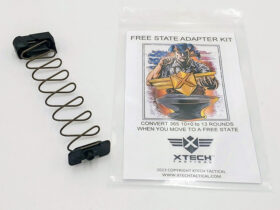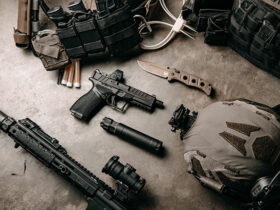In days of shortage and panic buying, those of us who enjoy shooting and testing firearms are at a disadvantage. We need to conserve ammunition. There has always existed a difficulty in some areas in finding a proper range for sighting-in a rifle. A 100-yard range sometimes requires considerable travel from the home. Indoor ranges and shorter 25-yard ranges are much easier to find.
Most of us like to use a 25-yard position to ‘get on paper.’ We may not be exactly on the zero at 100 yards, but we will be close. Close enough that when we have the opportunity to zero the rifle for 100 yards, we will be able to do so with a minimum of shots fired. Today, that is what it is about, using less ammunition!

Sighting-In a Rifle
When sighting-in a rifle, the first goal is to understand the likely range for the game we are going to be taking. As an example, the Ruger .22 Magnum rifle I use for small game is best sighted for 25 yards. I like to know where it would hit at 50 yards, but I have never taken a shot past 25 yards with this rifle.
With the .308 rifle, I like the zero to be about 1.5-inch high at 100 yards, giving me a sure chance of hitting the game animal in the vitals at 200 yards, since the point of impact will be just a couple of inches low. There is no ideal set range for sighting-in a rifle for everyone, we must be aware of the likely range at which we will be using the firearm.
No rifle cartridge is a laser beam. Bullets behave in a predictable manner. They rise above the muzzle, then they drop at longer distances. A .223 Remington is a flat-shooting cartridge by many standards. The .308 Winchester is superior to many, and the .30-30 Winchester and .35 Remington are woods cartridges with greater drop.
I have a friend that has hunted from the same stand for many years. He looks out over a field that is perhaps 150-yards wide. He has taken shots close to the stand and at the very edge of the clearing with good success because he knows his rifle. Some of us are not so lucky. We may encounter shots that vary to a greater extent. We may encounter shots at the end of our sure-hit zone. We must understand the rifle and its accuracy potential and our own limitations.

Know Your Zero
I have sighted in my rifles at short-range distances for many years, and in the end, I have ended up with rifles that are useful from 25 to 250 yards, with the same zero. I don’t have to turn a turret and reset the zero. Those who are good shots and have excellent skills may be able to turn the turrets at longer range and keep on top of things. That isn’t me, but I have good confidence in what I am doing with my personal rifles and the zero.
Sighting-in a rifle for the load and the range is important. Different bullet weights strike to a different point of aim. A 150-grain and a 180-grain .308 bullet strike to different points of aim. The same goes for 55 and 69-grain .223. You have to understand this, as well as the likely distance to you will be engaging the target.
Don’t let the traditional 100-yard zero set your goals, judge the zero you need by the likely chore to be performed. The advantage of the zero should be that you will hold the sights on the target and not be out of the kill zone of the game between 25 and 200 yards. (Given a modern relatively flat-shooting cartridge.)
It also depends on whether you prefer the high-shoulder shot or the heart shot on deer. A deer has a six-inch sure-kill zone. I prefer to err on the side of caution and hold closer. Just the same, this is a generous kill zone within perhaps 200 yards of possible shots. If you aim for the center of the target, you may strike three-inches low or three-inches high, but you will be in the kill zone. You will still have to calculate, but you will not have to calculate as long — taking the rifle up and thinking about the shot will take less time.

I have fired the Springfield Victor, my go-anywhere do-anything .308, and found it accurate, reliable and capable to center hits on deer-sized game from zero to 220 yards. It stays in the deer-sized kill zone at that range. This is assuming you can shoot. If you don’t have the practice in, then the range may be limited to 100 yards until you attain more skill. But then this means a perfect shot and off-hand skill is another matter.
A factor that isn’t part of the equation is the zero. You have already done the work in this area. I love a scope with hash marks. Memorize the zero and use hash marks for hold-over or hold-under.
Practice, Practice, Practice
Once you have the zero, then practice at every opportunity. Fire at small targets at both known and unknown ranges. Shooting paper is important, but so is consistently striking the target at known and unknown ranges.
An inch-wide target is a nice small target you should be able to strike consistently with practice. This must occur on a regular basis at 100 yards with the .308. With the Ruger American Rifle in .22 Magnum, several shots in an inch at 25 yards is easy. The limiting factor here is the cartridge and its power. If you miss the target at shorter range — say by a half-inch — you will be much further off at longer range. Sight the rifle in at 25 yards and then confirm the zero at 100 yards and you are in like Flint.

Scope Turrets
The windage turret is on the right side of the optic. This turret is used to adjust horizontal point of impact. This turret moves the point of impact either right or left. The elevation turret is on the top of the scope. This is used to adjust the vertical impact of the rifle scope. The up or down impact is adjusted using this turret.
While horizontal must be dead-on, you may wish to set elevation higher in order to be able to fire accurately at longer distances. Set the rifle to fire high at a certain distance and it will be on-target at longer distance.
How do you sight your rifle in? Do you have any other tips or hacks to help your fellow shooters? Let us know in the comments.
Editor’s note: This post was originally published in December of 2020. It has been completely revamped and updated for accuracy and clarity.










Leave a Reply